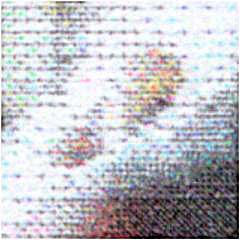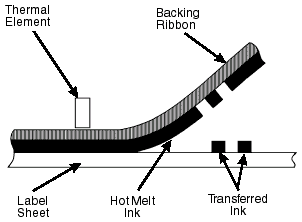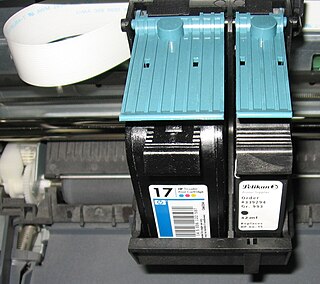
In computing, a printer is a peripheral machine which makes a persistent representation of graphics or text, usually on paper. While most output is human-readable, bar code printers are an example of an expanded use for printers. The different types of printers include 3D printer, inkjet printer, laser printer, thermal printer, etc.

Laser printing is an electrostatic digital printing process. It produces high-quality text and graphics by repeatedly passing a laser beam back and forth over a negatively charged cylinder called a "drum" to define a differentially charged image. The drum then selectively collects electrically charged powdered ink (toner), and transfers the image to paper, which is then heated in order to permanently fuse the text, imagery, or both, to the paper. As with digital photocopiers, laser printers employ a xerographic printing process. Laser printing differs from traditional xerography as implemented in analog photocopiers in that in the latter, the image is formed by reflecting light off an existing document onto the exposed drum.

Inkjet printing is a type of computer printing that recreates a digital image by propelling droplets of ink onto paper and plastic substrates. Inkjet printers are the most commonly used type of printer, and range from small inexpensive consumer models to expensive professional machines.

The Eastman Kodak Company is an American public company that produces various products related to its historic basis in analogue photography. The company is headquartered in Rochester, New York, and is incorporated in New Jersey. Kodak provides packaging, functional printing, graphic communications, and professional services for businesses around the world. Its main business segments are Print Systems, Enterprise Inkjet Systems, Micro 3D Printing and Packaging, Software and Solutions, and Consumer and Film. It is best known for photographic film products.

Dye-sublimation printing is a computer printing technique which uses heat to transfer dye onto materials such as a plastic, card, paper, or fabric. The sublimation name was first applied because the dye was considered to make the transition between the solid and gas states without going through a liquid stage. This understanding of the process was later shown to be incorrect, as there is some liquefying of the dye. Since then, the proper name for the process has become known as dye-diffusion, though this technically-correct term has not supplanted the original name. Many consumer and professional dye-sublimation printers are designed and used for producing photographic prints, ID cards, clothing, and more.

Dots per inch is a measure of spatial printing, video or image scanner dot density, in particular the number of individual dots that can be placed in a line within the span of 1 inch (2.54 cm). Similarly, the more newly introduced dots per centimeter refers to the number of individual dots that can be placed within a line of 1 centimeter (≈ 0.393 in).

Giclée is a neologism coined in 1991 by printmaker Jack Duganne for fine art digital prints made on inkjet printers. The name was originally applied to fine art prints created on a modified Iris printer in a process invented in the late 1980s. It has since been used loosely to mean any fine-art printing, usually archival, printed by inkjet. It is often used by artists, galleries, and print shops to suggest high quality printing, but is an unregulated word with no associated warranty of quality.

Thermal-transfer printing is a digital printing method in which material is applied to paper by melting a coating of ribbon so that it stays glued to the material on which the print is applied. It contrasts with direct thermal printing, where no ribbon is present in the process.

Digital printing is a method of printing from a digital-based image directly to a variety of media. It usually refers to professional printing where small-run jobs from desktop publishing and other digital sources are printed using large-format and/or high-volume laser or inkjet printers. Digital printing has a higher cost per page than more traditional offset printing methods, but this price is usually offset by avoiding the cost of all the technical steps required to make printing plates. It also allows for on-demand printing, short turnaround time, and even a modification of the image used for each impression. The savings in labor and the ever-increasing capability of digital presses means that digital printing is reaching the point where it can match or supersede offset printing technology's ability to produce larger print runs of several thousand sheets at a low price.

A minilab is a small photographic developing and printing system or machine, as opposed to large centralized photo developing labs. Many retail stores use film or digital minilabs to provide on-site photo finishing services.
Print permanence refers to the longevity of printed material, especially photographs, and preservation issues. Over time, the optical density, color balance, lustre, and other qualities of a print will degrade. The rate at which deterioration occurs depends primarily on two main factors: the print itself, that is, the colorants used to form the image and the medium on which image resides, and the type of environment the print is exposed to.
An Iris printer is a large-format color inkjet printer introduced in 1985 by Iris Graphics, originally of Stoneham, Massachusetts and currently manufactured by the Graphic Communications Group of Eastman Kodak, designed for prepress proofing. It is also used in the fine art reproduction market as a final output digital printing press, as in Giclée.
Noritsu Koki Co., Ltd. is a photo processing machine manufacturer based in Tokyo, Japan. In Japan it also makes and sells other products such as brush pen tips. It is the owner of AlphaTheta Corporation which owns the Pioneer DJ brand.

Kodak EasyShare is a sub brand of Eastman Kodak Company products identifying a consumer photography system of digital cameras, snapshot thermal printers, snapshot thermal printer docks, all-in-one inkjet printers, accessories, camera docks, software, and online print services. The brand was introduced in 2001. The brand is no longer applied to all-in-one inkjet printers or online printing services. Thermal snapshot printers and printer docks product lines have been discontinued. In 2012, Kodak stopped manufacturing and selling all digital cameras and photo frames.

An ink cartridge or inkjet cartridge is a component of an inkjet printer that contains the ink that is deposited onto paper during printing.

Inkjet paper is a special fine paper designed for inkjet printers, typically classified by its weight, brightness and smoothness, and sometimes by its opacity.
A compact photo printer is a stand-alone inkjet printer designed to produce 4×6 or 2×3 inch prints from digital cameras. It works without the use of a computer. It is also known as a portable photo printer or a snapshot printer.

Durst is an Italian manufacturer of photographic printing equipment.

Digital textile printing is described as any ink jet based method of printing colorants onto fabric. Most notably, digital textile printing is referred to when identifying either printing smaller designs onto garments and printing larger designs onto large format rolls of textile. The latter is a growing trend in visual communication, where advertisement and corporate branding is printed onto polyester media. Examples are: flags, banners, signs, retail graphics.
A contract proof usually serves as an agreement between customer and printer and as a color reference guide for adjusting the press before the final press run. Most contract proofs are a prepress proof.













